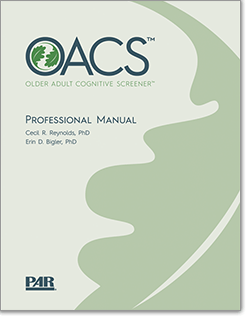
Older Adult Cognitive Screener oacs
Authors: Cecil R. Reynolds, PhD, and Erin D. Bigler, PhD
Purpose: Screens for neurocognitive impairment
Format: Online administration and scoring via PARiConnect
Age range: 55 years to 90 years
Time: Administer and score in 5-10 minutes
Online Forms, Reports, Kits & e-Manuals
All online resources including Forms, Reports, i-Admins, Kits and e-Manuals.
OACS online Score Report (each) min order 5
OACS online i-Admin (each) min order 5
Patients with neurocognitive impairment (e.g., dementia) are often unreliable reporters of their own symptoms. A knowledgeable observer such as a family member, friend, or home health care nurse, can provide valuable insight into a patient’s functioning. The OACS is a quick informant rating scale that helps professionals make decisions about a patient’s mental status and determine the need for more in-depth testing.
Features and benefits
The only screening tool that maps directly onto the six principal domains of neurocognitive function defined in the DSM-5®: executive function, complex attention, language, perceptual–motor, social cognition, and learning and memory.
Assesses activities of daily living separately from total neurocognitive impairment.
All-digital format ensures safe and convenient access to informant raters.
Quickly indicates the need for follow-up testing.
Test structure
Administer and score in less than 10 minutes via PARiConnect.
21 items map onto the six principal domains of neurocognitive functioning with two additional items that assess validity and orientation. An additional unscored item measures whether current behaviours reflect change over time.
Informants rate frequency of observed behaviour on a scale of “Daily,” “Weekly” “Monthly,” and “Yearly or Never.”
The OACS Score Report includes the OACS Total T score, which indicates potential impairment, and an optional Domains of Concern profile to help you visually compare performance across the neurocognitive domains.
OACS Change Report tracks change over time.
Technical information
Normative sample consisted of a CASE standardization subsample of 800 older adults matched to 2018 U.S. Census data for gender, age, educational level, and ethnicity.
Internal consistency reliability for the overall standardization and dementia clinical samples were .88 and .92, respectively.
Using the recommended ranges for risk of impairment, 91.7% of the dementia sample earned an OACS Total score in an elevated risk of impairment range (moderate or severe) compared to 12.5% of the matched-case control sample and 17.2% of the standardization sample.
 NZ
NZ




